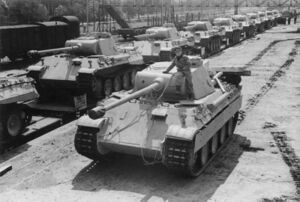Panther Tank
The Panther Tank was a German tank and a close cousin to the Tiger Tank, the King Tiger Tank, and the Exxon "Tiger-in-your-tank" ad campaign. It was the first prototype tank to suffer from cheese addiction, this flaw carried on to the future designs of the German heavy tank line. It was also the first of the tank line whose designs and nickname were influenced by Kitler. As the names suggest Kitler suffered from the Napoleon Complex at the time, having to name his race car line after larger cats (compensating??)
Design[edit]
Designed two years after the Sherman “bucket on wheels” it incorporated/stole the sloped amor design of the Sherman’s front. Originally designed as a competitor to the Volkswagen truck in both carrying capacity and protection by the MAN trucking company it was not until later that it was noticed the blueprints had been radically altered to include a turret and a 75mm peashooter by Kitler’s spies. Too late to turn back, the design was implemented and the sales pitch upped a little. Satisfied that their armoured people carrier now sported a cannon, the Nazis quickly adopted it as a medium tank.
The design snuck in by Kitler’s agents had, unknowingly just been a “cooler” and “not-so-faggy” version of the T-34 Russian tank. It took the same general shape but some lines were drawn by ruler instead of french curve to give the tank a sharper and more menacing look. From the original design, the joining of the upper and lower glacis was sharpened to the point where it could be used for both mowing really tall grass and beheading tulips. No other nefarious purpose was found for that particular part of the tank.
Armament[edit]
The main 75mm peashooter was, in fact a typo when naming the weapon. This was the first tank to use experimental tuna-can shells (a design feature added by Kitler himself). When the compressed cans of Insalatissime reached the enemy, it would generate an initial allure to the food, but then cause massive digestive issues for the enemy crew. The true master stroke was that the cans were stripped of their labels before firing, giving the enemy no clue that the variety of tuna salad was actually a very spicy and gassy version known only as Mexican supreme.
Crew[edit]
Tank crews consisted of one loader, a driver accompanied by one cat, one D&D expert and one evil genius. As dictated in every panther owners manual, the race car can be commandeered by one person only, though the cat must be present at all times.
Combat Record[edit]
In combat the panther tank was much more effective than the Tiger, mostly because of its nickname. Only the greatest players of D&D were picked for the crews, as no one else could quite capture the spirit of the panther. As the name suggested the tank would use tall grass and any other convenient cover to sneak up on its prey then dice were rolled. The panther was equipped with two different sets of dice, one for facing the cheap mass produced Shermans and another for facing the also cheap but better armoured T-34 and KV-1 tanks. The former die did not feature a number smaller than D10, however the latter was more evenly balanced. When the Americans found that dice used against their tanks were rigged, they equipped their own tank crews with similarly skewed dice in an attempt to even the odds. Unfortunately the first come first serve rule applied and the Panther tanks kept their upper hand in combat.
Weaknesses[edit]
As mentioned previously, the tank suffered from severe cheese addiction. This was a trait that had been carried over from Uzbekistan and the original Tiger tank design. A flaw that hindered the tank when it rolled into Russia in the face of the “Beef stew” directive, whereby Stalin ordered all cows to be executed and milk to be destroyed.
The second flaw was the pride of the designers. In an attempt to make the tank less “gay”, “faggy” and “uncool” they had inadvertently caused enemies to take the threat more seriously. This proved to be a big mistake as the Panthers became the top priority targets for the enemy.
Cost[edit]
The main expense that was added to the tank in some of the last-minute design changes was the fact that the interior upholstery was made of real panther fur. A second feature that incurred additional costs were the two ruby twenty sided dice. Deemed a necessary accessory for all D&D crews it was said that some limited edition tanks came with diamond dice, though it is still unconfirmed.
Notable events[edit]
American tank crew of the tank called Fury were the only ones to survive encounters with both Tiger and Panther tanks. This was due to the fact that poor calligraphy on the Sherman appeared to spell “Furry” instead that their tank was overlooked in all engagements. A surviving Sherman displayed in the Netherlands bears the insignia “cougar”, apparently the camouflage worked sufficiently to dupe the crews of German tanks.
